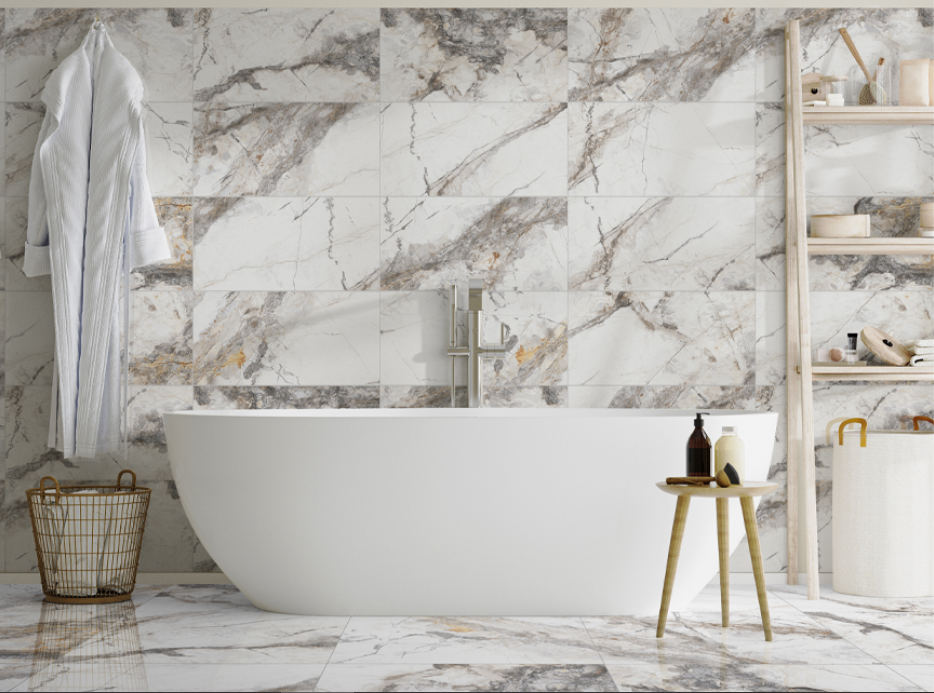When it comes to selecting bathroom tiles, you need to consider more than just aesthetics. The right tiles can withstand moisture, foot traffic, and even stains. Start by understanding the different materials available and their specific properties. This knowledge can guide you toward making informed choices that balance durability with style. But before you commit, there are several key factors to explore that could impact both the look and longevity of your space.
Understand Different Tile Materials
When you begin selecting bathroom tiles, it’s essential to understand the different materials available, as this choice can significantly impact both aesthetics and functionality.
Ceramic tiles offer durability and a range of pattern designs, while porcelain tiles are denser and more water-resistant.
Natural stone brings unique textures, ensuring each tile is one-of-a-kind. Glass tiles add a modern touch, reflecting light beautifully.
Vinyl options provide budget-friendly versatility, and mosaic styles can create stunning visual effects.
Consider various tile sizes and eco-friendly materials for a sustainable choice. Textured surfaces enhance grip, making your bathroom both stylish and safe for daily use.
Assess Water Resistance Ratings
After exploring various tile materials, it’s time to focus on how well they stand up to moisture.
Start by checking the water resistance ratings, which indicate a tile’s ability to resist moisture absorption. Look for products that have undergone waterproof testing to ensure they can handle bathroom conditions.
Low moisture absorption is key, as it prevents mold and mildew growth, prolonging the life of your tiles.
Porcelain and ceramic tiles typically excel in this area, but always verify the manufacturer’s specifications.
A well-chosen tile will maintain its beauty and functionality, keeping your bathroom a safe and inviting space.
Consider Slip Resistance
How can you ensure your bathroom tiles are safe underfoot?
Prioritize slip resistance by exploring various traction options. Look for tiles with textured surfaces or those specifically designed with safety features that enhance grip, especially when wet.
The coefficient of friction (COF) is crucial; aim for tiles with a COF rating of 0.60 or higher for optimal safety.
Additionally, consider using mats in high-risk areas like near the shower or tub.
Evaluate Durability and Hardness
When selecting bathroom tiles, it’s crucial to understand the materials you’re considering.
Different tiles offer varying levels of durability, so assess their PEI ratings to ensure they can withstand the wear and tear of a wet environment.
This knowledge will help you choose tiles that not only look great but also stand the test of time.
Understand Tile Materials
Choosing the right tile material for your bathroom is crucial, as it directly impacts both aesthetics and functionality. Understanding the differences between options helps you make an informed choice.
- Ceramic vs Porcelain: Ceramic tiles are generally less dense, making them more susceptible to moisture, while porcelain offers greater durability and is more water-resistant.
- Natural Stone: While stunning, natural stone requires more maintenance due to its porous nature, which can lead to staining.
- Durability and Hardness: Always prioritize hard, durable materials that withstand the wear and tear of daily use, ensuring your bathroom remains beautiful and functional for years to come.
Assess PEI Ratings
While selecting bathroom tiles, understanding the Porcelain Enamel Institute (PEI) ratings can significantly enhance your choices regarding durability and hardness. Kitchen tiles.
The PEI classifications range from I to V, indicating how well tiles can withstand foot traffic and wear. For optimal tile longevity, aim for a rating of III or higher, especially in high-traffic areas.
Class I tiles are best for walls, while V-rated tiles excel in durability for commercial spaces.
Factor in Maintenance Requirements
Although bathroom tiles can enhance your space aesthetically, you can’t overlook their maintenance requirements.
Consider how often you’ll need to clean your tiles and their stain resistance before making a choice.
· Choose tiles that require minimal cleaning frequency.
· Opt for materials with high stain resistance to simplify upkeep.
· Factor in grout maintenance, as it often demands more attention.
Choose the Right Finish
When selecting bathroom tiles, the finish you choose can dramatically affect both aesthetics and safety.
Glossy tiles may add a sleek touch but can be slippery when wet, while matte finishes offer better grip and easier maintenance.
Consider how each option aligns with your style and cleaning preferences to create a functional yet beautiful space.
Glossy vs. Matte Finish
How do you choose between glossy and matte finishes for your bathroom tiles? Both options have unique traits that can transform your space.
- Glossy benefits: They reflect light, making small bathrooms appear larger and brighter.
- Matte advantages: They offer a more understated look and are less prone to showing water spots.
- Aesthetic choice: Consider your overall design vision—glossy tiles shine in modern setups, while matte tiles suit rustic themes.
Ultimately, your selection should align with your style and practical needs.
Weigh these factors carefully to create a bathroom that’s both beautiful and functional.
Slip Resistance Importance
Choosing bathroom tiles isn’t just about aesthetics; slip resistance is a crucial factor that can impact safety.
When selecting tiles, consider their safety features, especially in moisture-prone areas. Opt for materials with traction surfaces to reduce the risk of slips and falls. Textured finishes or specific anti-slip coatings can enhance grip, ensuring you and your family stay safe.
It’s essential to check the coefficient of friction (COF) rating, as higher numbers indicate better slip resistance.
Maintenance and Cleaning Ease
While selecting bathroom tiles, you should definitely consider maintenance and cleaning ease, as the right finish can make all the difference. A smooth, glazed finish often requires less effort to clean and maintain, allowing you to enjoy your space without worry.
Consider these factors:
- Resistance to Stains: Some finishes repel dirt and grime, making it easier to wipe away.
- Compatibility with Cleaning Products: Ensure your tiles can handle the products you prefer without damage.
- Regular Maintenance Schedule: Choose tiles that fit your cleaning routine, keeping them looking fresh for years.
Think About Color and Style
As you embark on selecting bathroom tiles, it’s essential to consider both color and style, since these elements can dramatically influence the overall ambiance of the space.
Color psychology plays a crucial role; for example, soft blues and greens evoke calmness, while vibrant yellows can energize.
Stay updated on style trends, whether you lean toward sleek modern aesthetics or classic vintage vibes.
Consider how your chosen tiles harmonize with fixtures and accessories, ensuring a cohesive look.
Plan for Installation and Grouting
After settling on the perfect color and style, it’s time to focus on the practicality of installing your bathroom tiles and ensuring the grouting is done right.
Here are some essential installation tips and grouting techniques to keep in mind:
- Prepare the surface well to ensure proper adhesion and alignment.
- Use spacers for uniform gaps, making grouting easier and neater.
- Choose the right grout type—consider waterproof options for moisture-prone areas.
With these steps, you’ll achieve a professional finish that enhances both durability and aesthetics, ensuring your bathroom tiles look great and stand the test of time.
Set a Budget and Stick to It
Setting a budget for your bathroom tile project is crucial, and it’s wise to outline your financial limits before diving in.
Start with budget planning by estimating costs for tiles, installation, and additional materials. Research various tile options—ceramic, porcelain, or natural stone—and gather price quotes to refine your cost estimation.
Don’t forget to account for unexpected expenses that may arise during the project. By sticking to your budget, you’ll avoid overspending and ensure your bathroom remains stylish and durable without breaking the bank.
Conclusion
Choosing the right bathroom tiles is vital for both aesthetics and functionality. By understanding materials, assessing water resistance, and considering slip resistance, you can ensure a safe and durable space. Evaluate durability and maintenance to keep your bathroom looking pristine with minimal effort. Don’t forget to factor in style and budget to create a cohesive look that reflects your taste. With careful planning, your tile choice will not only stand the test of time but also elevate your bathroom’s appeal.



